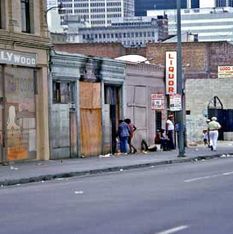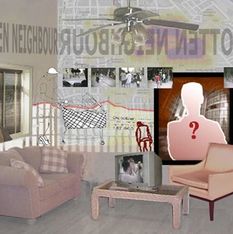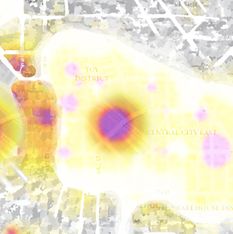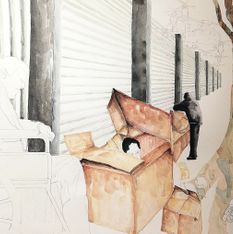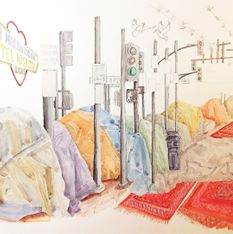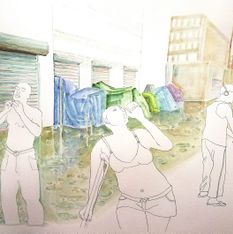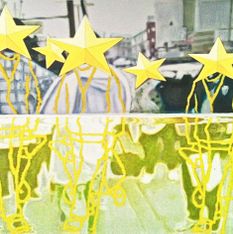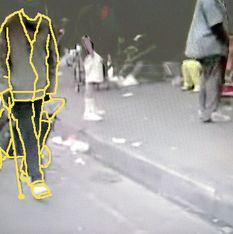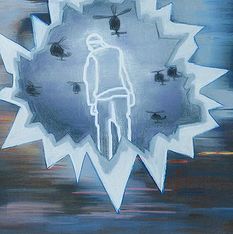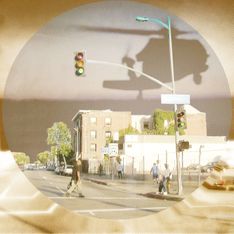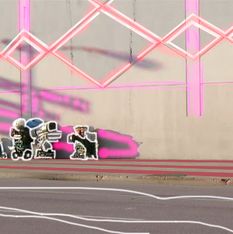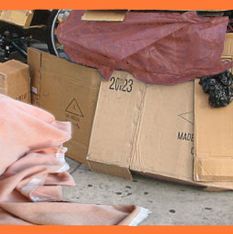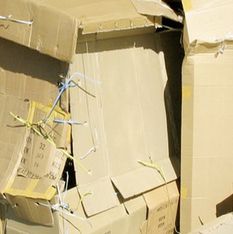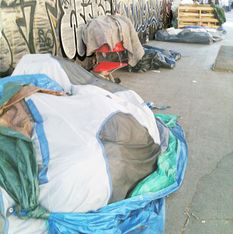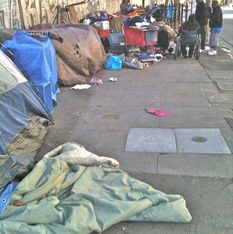birgitte moos chalcraft
'PEOPLE COME BACK, TRANSFORMED' (forgotten neighbor)
Site-specific Pop-up Installation in Skidrow, Downtown Los Angeles "People Come Back, Transformed"s primary focus is on homeless new veterans. The project is produced as a site-specific pop-up installation, specifically placed in Skid Row Downtown L.A. An area associated with an increasing number of homeless people, settling in the streets.
The installation becomes a player in a scenario, in the sense that the installation is not an object that is seen as detached from its location. On the contrary, the installation connects, interacts with, and affects the local community, its social spaces, and people in the surrounding city. The location, spatial solution, and content of the installation are a direct response to Skid Row's development, where a link between several new veterans and rising homelessness seems to be largely ignored by society.
The intention behind "People Come Back, Transformed" is to have a positive impact on the development of the reality in Skid Row. To shape the future of Skid Row in real life, and to generate an understanding that there is a correlation between the psychological consequences of war and the living conditions afterward, for those who have been to war. The project further aims to reach a wider audience in order to raise a wider population's awareness of the alarming situation in Skid Row, in the hope that the homeless will receive more help and acceptance than at present.
During this project, I walked many hours in the streets of Skid Row, where I interacted with homeless veterans to become familiar with them and their personal stories. Read more below pictures...
CLICK on images to enlarge
'PEOPLE COME BACK, TRANSFORMED' - ART STATEMENT by Birgitte Moos Chalcraft
Project description
In 2003, I moved to Downtown L.A., into the area, which was later named The Arts District. Here I witnessed the tragedy of countless homeless people on the street, mainly in Skid Row. After my stay in Downtown and my return to Denmark, I often reflected on the problem of the growing number of homeless veterans in America. Right now, the number of homeless veterans is exploding in the United States, where one of 10 homeless people are veterans. That's why I illustrated this theme through an installation project. The project intervenes in the social and urban space, that houses a unique population mix of homeless residents, Skid Row of Downtown LA.
Downtown Los Angeles
L.A. itself is a cosmopolitan magnet that attracts success-hungry and talented people from around the world while being the city of the United States with the highest proportion of homeless people. The largest number of the city's homeless are staying in Downtown's Skid Row.
Downtown was the city's financial sector, with some of the biggest banks in the world, and workers commuted to and from by car. A few years ago, the streets of Downtown were deserted after dark, and only the homeless could be at peace. Then in 2005, one of the world's largest artist colonies, The Arts District, was officially established in the area where empty industrial buildings had been taken over by artists. Now Downtown has transformed into L.A.s vibrant urban centrum. A complex society in the city's historic core, currently dominated by gentrification, private real estate development, and New Business Development along with the L.A. County Jail, and the Federal Courthouse. The district's original theaters have been reopened, and cultural centers such as L.A. Opera, Walt Disney Concert Hall, Moca, Staples Center, LA Main Public Library, LA Times, Union Station, and Sci-Arc are located there. A large number of art galleries open and close in Gallery Row, centrally surrounded by billion-dollar skyscrapers. At the same time, a growing number of homeless Iraq and Afghanistan veterans are settling in the streets between private housing, traffic jams, and what is unusual for L.A., namely lots of pedestrians.
FACTS ABOUT SKID ROW
Just a few blocks from central Downtown is Skid Row. An area spanning 10 blocks, which is half a square mile, populated by between five and eight thousand homeless, mainly African-American people. In 1967 Skid Row was labeled The Containment Zone, when the city of Los Angeles turned it into one area to gather homeless. This policy includes dropping mentally ill patients from hospitals off in the streets of Skid Row. It was legal until 2016, but apparently it still happens.
Skid Row is a blend of run-down low-cost hotels, warehouses and wholesale storefronts. The streets are littered with rubbish, and its sidewalks are lined with tents, cardboard boxes and makeshift camps inhabited by about 4,000 homeless people who cannot afford a regular home or maintain a sustainable life. The remaining homeless live in run-down social housing, missions and shelters. The area has been burdened with unsanitary conditions, high crime rates and vagrancy almost since it developed back in the 1880s, during the rise of L.A.
Homeless people are being helped by local homeless shelters such as Union Rescue Mission, Charity L.A. Mission, and health centers. The missions offer free beds, food, clothing and bathing facilities to the homeless. The housing provides single-occupancy units, in missions and in old hotels or apartments. The missions have established education and employment programs, as well as addiction programs. Despite many of these units and programs, it is nowhere near enough to house Skid Row's population. The streets are still lined with tents.
The causes of homelessness are plenty. Many homeless people have mental health problems. Mental health systems are difficult to navigate and it's hard to get what the individual needs. Others have become unemployed, had family breakdown, or drug and alcohol addiction issues. And then there are the veterans, that didn´t manage to get back to their feet after the military.
The harsh reality of Skid Row is wild, ravaged by alcohol and drug addictions, violence, thefts, murder, prostitution, mental illness and other visible health problems. Many people are high, mostly on crystal amphetamines, or opioids. Pastor Antwone Sanford, manager of The Mission's emergency services and outreach program explains that "When life is hard like this - they turn to drugs like crystal meth ... And once you open that door, that drug, that chemical will take over." People are also openly involved in street transactions and dealing drugs. One hit of meth is only a two-dollar blow, so people easily get caught in dependency. When they're on drugs out there in the streets, it just run people down. They rather by drugs than food, and stop caring for themselves. There are tweakers everywhere and it is very very dangerous. A tweaker is someone coming down from a high, that may have been lasting anywhere from three days to weeks. People go crazy because of sleep deprivation and withdrawal symptoms, and a meth-addicted person who blows up, will do anything for a hit.
Street Research
Back when I started this project, I drove around in Skid Row and was sometimes followed by the police. This is a fact as I several times pulled over to the sidewalk to check if the police were really following me. And quite rightly, the police parked behind my vehicle and waited until I drove again. I don't know if they thought I was a prostitute, a drug dealer, or anything else. Maybe they protected me? In any case, it was unpleasant.
Later, I spent many hours walking in Skid Row to find out what was going on. I walked alone, apparently the only white nonhomeless woman in the area. I never really told anyone in The Arts District about what I was doing until after my return to Denmark in spring 2014. There I wrote with a female Downtown L.A.-based artist, Azure Blue, about the Skid Row experience. It turned out she was doing street art in Skid Row at night. Sometimes in the company of our mutual artist friend Wild Life.
I went to The Midnight Mission in San Pedro Street in 2013 and asked the receptionist about how I could connect with new homeless war veterans, and was then escorted to what I remember as the manager's office. I told I was doing an art project about new homeless veterans in Skid Row, where I'm merging art and psychology. Then he asked me "who pays for this?" I replied that it was a volunteering job as an artist. The answer obviously surprised him, and out of thin air - or because of surveillance cameras - several people showed up at the office.
When asked why, I just replied that I simply can't comprehend why there is such an injustice in American society, with racialized elements of homelessness, and why American soldiers when they return from war, are expelled from society after serving their country. It makes no sense and is so unfair, and they are considered psychos, at the risk of ending up in the streets, stigmatized as dangerous and contagious. I mentioned that I've heard young men were promised $50,000 to join the army, and I understand these guys' choices, given they otherwise wouldn't have had a chance to educate themselves and move on in their lives. The economic offer is an enticing opportunity to rise above the limiting social conditions and heritage with which they may have either been born into or raised.
Just to come back from war, traumatized and then treated this way, despite the fact that many veterans have mental disorders as a result of serving the army. I explained that in my opinion, everyone is equal, and veterans deserve to be received with dignity, especially after what they have been through during military training and battlefields.
In conclusion, I mentioned my Danish background. From a Danish perspective, the circumstances of veterans and homeless people are appalling, beneath human dignity. I pointed out that my intention is to inform a wider world and help prevent a continued cycle of injustices.
In the office, several African American men had gathered and a few of them had tears in their eyes when they heard my reasons. So I also came to cry and instinctively experienced a heart connection with strangers.
They seemed pretty happy with my idea, and one of them offered to go out into the streets with me and connect me to new veterans. He made it clear that I should stay close to him because the streets are very dangerous, especially if people don't recognize one. He was incredibly friendly and our introduction created an invisible but noticeable connection between us. He was obviously living in Skid Row, so I wondered if it would be humiliating or condescending if I offered him money for the help. He didn't seem to be on drugs, so I assumed the money wouldn't be used for that purpose. We met several times where I gave him $5 to take me to people. It seemed like a fair deal.
My self-defined role was to approach new veterans, to ask into, and listen to their experiences. It created openings and trust between us that they were given the opportunity to tell their stories, received with compassion. The word even spread, and homeless veterans began contacting me in the streets. So therefore I had a lot of conversations with veterans, and below are a few examples of this:
One homeless veteran told me he had been brutally assaulted three times during the year he had lived in Skid Row. Another young veteran who was obviously super high on meth became very emotional with despair in his eyes when I asked him if he had been deployed. He broke down completely and the words gushed out of him about how terrible it had been. He begged crying for help and mercy "I don't stand a chance, I don't know what to do, no one's helping me." I looked through him into his soul and felt the pain, and that insight plagues me to this day with a deep sadness.
I even befriended someone who once had a successful career as a well-known musician. He was a former soldier and became a heroin addict. Therefore, he had no power to get on his feet and continue his artistic career after returning from the war. He switched residence from Skid Row to an alley behind the house I lived in The Arts District and sang his famous tunes in front of our windows. He got better by getting off Skid Row.
I thought I became street smart, but was still naïve, and could have been killed. Shortly before I returned to Copenhagen in the spring of 2014, a young guy suddenly appeared right in front of me and many others, with a serious gun between his hands. He looked me in the eye and, thank God, turned away. I managed to perceive the expression in his eyes, and the situation was not for fun. People, myself included, instinctively took cover behind cars as he ran around confused. In less than two minutes, he was surrounded by seven or eight police cars and a dozen armed officers who nailed him to the ground. Immediately after the incident, I heard he was a new veteran. I suppose he had flashbacks to war-zone experiences. In fact, I got symptoms of post-traumatic stress after this episode.
Research as artistic practice
The research phase of the project, as described above, consists of urban studies in the lives of the homeless on the streets of Downtown. I interact with homeless veterans by walking and talking in the streets and asking permission to interview them while documenting visually, by taking photos and video. Footage of their lives on the street is produced as a docu-drama video. Research for the video also digs into new American war films and Hollywood film versions of returning American soldiers. It takes place at The American Film Institute in L.A., and I've researched American media coverage of the Iraq and Afghanistan wars, at the L.A. Main Public Library in Downtown L.A.
I got in touch with the Department of Veterans Affairs in Downtown to volunteer as an art therapist at workshops for new veterans. I wanted to establish this close contact, combined with my observations from the direct street interactions, to create a deeper understanding of the psyche of veterans than I would otherwise have achieved.
The site-specific Installation
The installation is created inside a pre-existing empty room with large windows, located at street level centrally in Skid Row. Everyday objects such as furniture, photographs, paintings and a video placed inside the installation, produce the experience of a living room.
The spatial solution and content of the installation reveal different layers of references to the context of war and homelessness. They reflect the theme of the project and create a story about the suffering of homeless veterans. The objects inside the installation are presented in a narrative form by a pre- and post-war platform that blends the realistic with the symbolic.
The video appears on a video monitor located in the installation. Image references from films about the wars have been edited together with my street recordings, in a docu-fictional attempt to create an abstract reality sensation that illustrates the soldiers' experiences during and after the war. Selected photos from my street search are framed and hung on the walls of the installation like grotesque sofa pieces. Some photos are manipulated digitally and others are printed as a base for paintings. Photos and paintings on the walls visualize veterans' war experiences, which are linked with themes associated with homelessness.
The interior shape and décor of the room are rigorous. An almost frozen tableau that symbolically perpetuates the past, while the images are hung staggered and partially layered. The picture frames are perfect, while the image content can be chaotic. The movement between the objects is a narrative in itself that indicates an underlying threat. My intention is to create an impression of a random principle where familiar content is broken up and stability is made unstable, illustrating how veterans have experienced taking off from their families and safe homes, going to war. This allows the space and power of the images to convey a "larger" space where physical reality is transcended. For the rest of us, it is impossible to imagine what it is like to be in a war zone. Therefore, preconceived opinions cannot be placed, but the content of the installation opens up new interpretive angles.
Roleplay and audience interactivity
In performance genres, one talks about integrating audiences, and take it for granted that scenic spaces implicitly include actors. In this project I am working with a reinterpretation of the performer role, by creating a space where actors do not have to be physically present, to the same degree as they traditionally are in a performative space.
In "People Come Back, Transformed", the actors are real people, namely the homeless that constantly exist outside the installation at street level. In this way, the project deals with acting and audience roles. Those involved are performers regardless of role. In this sense, the installation serves as a platform for audience interactivity, inviting the audience, people outside, to become co-players.
Despite the fact that actors are not present inside the room itself, references to human activities related to what is presented inside the installation, and its location, are indicated. In this way, the dynamic location associated with urban and social space creates new real-time performance experiences. With this emerges a new cultural landscape, with mutual communication between the space, people outside this, and society.
What I hope to achieve is that passing pedestrians, regardless of gender, age and background feel invited to engage in the content of the installation, and find the experience interesting enough to reflect on. It is my intention that this project brings deeper insight and emotional impressions about what it means to be a homeless veteran in Skid Row, thereby creating greater empathy and understanding of the situation of the homeless. Both in the local community and from a wider population, which is hereby made aware of the need for pathways to self-sufficiency and lasting life changes for the homeless.
Consequences of war amongst veterans
The uninhabited but furnished installation indicates that its former residents moved out as a result of the consequences of war: The returning soldiers’ psychological reactions, rarely followed up in the United States, often lead to failed marriages. Thousands of veterans live with post-traumatic stress and flashbacks of sudden death, and the battlefields they experienced. Images of raw brutality in harsh vivid colours, the result being that they are unable to function either in their families or in society.
"People Come Back, Transformed" touches on a number of issues that include the American community's attitude to wars, health and mental illness, racial injustice, disability, social conditions and lack of health care and health insurance. Poverty is a big problem in the United States, and the economic crisis just makes it bigger. There are far too few financial resources to help veterans when they return, and this is not the first time in American history. A tsunami is a term used to describe something that can happen without warning and has been used as a metaphor for what can happen when the number of returning soldiers are booming in the United States.
Interdisciplinary set design
My hope is to engage with and co-create a new and time-relevant future performance landscape consisting of interdisciplinary performative experiments, and elements from the visual arts scene. The project's strategy challenges tailored separations between disciplines. The interdisciplinary approach integrates several art forms and pushes formal boundaries for different artistic genre descriptions while contributing to the development of performance art.
I am so engrossed in the integration of scenography and artistic genres that in 2012 I submitted a Ph.D. project proposal, "Revolutionary Spaces - Interdisciplinary set design after post-modern theatre" to The Royal College of Art´s School of Architecture in Copenhagen. Architecture is an ideal platform for staging non-traditional theater, as carried out in "People Come Back, Transformed". I also sent the Ph.D. project proposal to Columbia University in NY. The latter at the behest of Professor Arnold Aronson, head of Columbia University's School of the Theater Arts. In 2011, my set design for "The Arsonists" at the Odyssey Theater was nominated for "The 32nd Annual L.A. Weekly Theater Awards for Set Design of the Year in LA".
Additional writing about homelessness in Skidrow by Birgitte Moos Chalcraft, October 12, 2020
A 2019 report, developed by the Los Angeles County Department of Public Health, reveals how the number of homeless deaths has doubled between 2008 and 2013. The causes of death are drug overdose and alcohol, violence, heart disease, transport, murder, and suicide.
In addition, illnesses such as typhus have returned, with 167 recorded cases in Skid Row in 2018. There have also been outbreaks of tuberculosis, staphylococcus and hepatitis A. As early as 2012, the unclean streets and human waste, combined with many more rats, contributed to a Hepatitis A outbreak in Skid Row, county health officials said. This was reported to the city as violations of health codes. The increased number of rats poses a danger of typhus, and city officials declared Skid Row as a typhus zone.
A lack of public support and care resources already stretched the conditions of the homeless to the edge. And right now, the COVID-19 pandemic is installing fear in those living an unprotected life in dangerously tightly packed rows of tents in the streets, with almost no access to handwashing, bathrooms and public facilities, or money to buy hand sanitizer. It is a recipe for disaster and the rapid spread of diseases. In the wake of this pandemic, California Governor Gavin Newsom has authorized funding $150 million in emergency protections for homeless people in CA. With this, spaces have been created for COVID screenings, testing and quarantine for the Skid Row population.
VOTE!
President Trump has made highly critical remarks about L.A.'s homeless issue in 2019 when he went on a fundraising tour across California in an attempt to raise about $15 million for the Republican National Committee and the president's re-election campaign. Trump claimed that homeless people have ruined Los Angeles and San Francisco. He told reporters that people living on the streets are a disgrace and it's inappropriate to do that to the United States, and a shame that the world is looking at this. He also said that people often moved from other countries to Los Angeles and San Francisco, and suddenly they have tents and live on the best streets and best highways, and at the entrances to the best buildings, in which buildings people pay tremendous taxes.
He blamed California Governor Gavin Newsom for the problem and even threatened to involve the Federal Govt. to clean up "the whole thing" if the governor can't solve the homeless crisis. Officials are also looking for potential places to relocate homeless people to.
The president's comments are totally unacceptable. They are not only disrespectful, but cold-hearted, and exhibit little or no concern for the homeless with an absolute lack of empathy. Instead, he emphasizes in a one-dimensional materialistic way that streets and doorways are more important than people's living conditions, and even refers to the tax-paying business owners. A horrifying joke at this moment when it turns out that Trump himself pays less tax than a low-income worker. It's an alarming signal to send. Isn't that both criminal and hypocritical?
For this, I should mention that the cost of living is rising, and Los Angeles has in recent years become extremely expensive to live in. Even a full-time job, earning a $15 minimum hourly wage can't pay rent, so more and more people are becoming homeless every month. In the United States, homelessness increased by 2.7 percent from 2018 to 2019, with as much as 12 percent in Los Angeles County.
What to do about the exploding scenario of homelessnes
From what I experienced through my walks in the streets, the problems of drug and alcohol abuse, mental health problems, postwar syndromes and broken family relationships are big. I believe that there are no easy solutions to help homeless people off the streets.
Imagine living in a scenario surrounded by substance abuse, people going nuts, diseases and only a cardboard box or a torn tent as your base in life, placed on dirty concrete sidewalks among rats, and the pandemic that is in full swing. In addition, with a constant threat of being subjected to violence or that your base is unexpectedly removed by the police. It is an inhuman disgrace, and uncertain lifestyle filled with sadness, paranoia and nowhere else to go. It is the hardest thing for many homeless people, almost impossible, to imagine being able to overcome.
Take, for example, people with neurologically conditioned mental health problems. Their impulse control is often reduced, and these individuals do not infrequently act in ways that are both impulsive and harmful, both to themselves and to other people. They are vulnerable, almost predisposed to drug use. And once that starts happening, it's really hard to avoid addiction. Especially when you live in the streets and are without family support systems. It creates hopelessness that makes it extra difficult to quit such addictions. It is already really challenging to overcome dependencies for people in jobs and families.
Neuropsychological research shows that people with mental illnesses have differently wired nerve pathways in the brain than people who do not suffer from one or more mental illnesses. I mention one or more since it is not unusual that when you have a mental disorder, this is often seen in combination with one or more other mental disorders. For example, it may be a combination of bipolar disorder combined with anxiety and depression. You can change the impulses of the nerve pathways, i.e. the messages that the brain sends to language and thought activity, or how the body should move. But it takes at least three months of consistent training of new behavior patterns and thoughts before the brain restructures the signals more permanently.
How would these people even have a chance to get out of homelessness without outside help?
Sometimes people need encouragement, professional help and motivation just to start imagining a better future. The best long-term outcomes for getting people out of homelessness are found by looking individually at what brought a person into homelessness and break it down to what keeps them on the streets.
The next steps are various aid programs offered in relation to individual needs, which are mainly about mental health, post-war effects, drugs, housing situations, unemployment and broken family relationships.
For people who experience homelessness due to mental health problems and postwar effects, it is important to offer a compassionate approach, with adequate therapeutic treatment. The missions can benefit from contact and collaboration with other helping facilities, such as The Veteran Affairs. War veterans should be offered conversation therapy. The same applies to people with mental illnesses, where access to hospitals and medical care is also most necessary.
Those who struggle with alcoholism and drug addictions should be offered treatment that ensures maintenance of sobriety, and difficulties associated with it. For some, it also includes learning about how to take care of yourself step by step, instead of ignoring and neglecting your health. The twelve-step program is very effective in the detoxing of both alcohol and drugs. However, it requires that the person who chooses to enter the program is personally motivated to be free of active addiction. Motivation can include visions of that a positive future is an opportunity. In this context, motivational personal mentors and coaching are needed.
The problem embedded in homelessness lies precisely the importance of having your own home and being able to maintain it. To keep a home, a former homeless person is required to have established an economic safety net that includes the means to pay rent. People who experience homelessness need to really improve their lives and become self-supporting. For this to happen, it is a great idea to offer educational programs and give people awareness of the benefits of education, and opportunities to train. Another option is to provide job training opportunities that prepare individuals for working life.
Finally, in order to support people on their journey out of homelessness, to become self-sufficient, resourceful follow-up programs are necessary. Those returning to family units should be offered mental health care in the form of counseling from professionals to everyone in the family and help should be continued until the family balance is restored. A family must also learn to relate to what a homeless person has been through and the underlying causes of homelessness.
Another important issue is coordinated effort to clean the streets of garbage and human waste, to reduce the spread of diseases on Skid Row. In the streets, only two public bathing facilities are available for about 4,000 homeless people, and social service providers have suggested that the county and the city could install more
This strategy and effort require time and money, and the lack of finances is the main challenge for most social service agencies. The missions in Skid Row rely on private funding. This happens in a city inhabited by many very very wealthy people.
Skid Row is labeled the epicenter of America's homelessness crisis, and the system doesn't address the situation well. City lawmakers have ignored this for many years. It's politics over people where government money and a growing economy have not flowed down to the low-income groups of people. It is a cynical attitude driven by selfish materialism, and this is a disgrace to humanity. Personally, I find it incomprehensible that
no more funding has been made available. But in America, there is a strong focus on individualism, which at the same time puts individuals at risk. In this, homelessness and income levels are often seen as the responsibility of individuals, which may explain why the extremely wealthy do not support homeless people with the necessary help to get off the streets.
An important direction to create a better future for people who have lost direction is to challenge the conventional ideas of individualism and wealth. This can be done in part by training the wider population in compassion, and in that, the causes of homelessness, poverty and suffering are complex, and far from always within the control of the individual. It entails free public education in what is brought in to one as a result of one's social conditioning throughout the upbringing, and about how adult people's free will and individual initiative can be undermined through childhood experiences. In the field of positive psychology, there is a theory of learned helplessness, as a result of children not being either heard or allowed to unfold through childhood or having been subjected to violence. The importance of learned helplessness goes without saying: the individual experiences oneself as helpless, ergo the individual cannot act constructively and proactively as an adult. And I bet many in Skid Row are unknowingly guided by their learned helplessness, and It's not their fault. It's a social pattern that's really difficult to break without professional therapeutic help.
An obvious contribution is free healthcare, and that the more fortunate citizens offer financial resources. Donating to build a few public bathing facilities and support that allow educational or social programs doesn´t reduce life quality for the rich. On the contrary, scientific studies within the field of positive psychology show charity work and meaningful accountability remarkably improve people's quality of life, whereas money in itself doesn't make one happy, but it does indeed give the freedom of choice.
An obvious contribution is free health care and that the more fortunate and prosperous citizens provide financial resources. Private donations to build more public bathing facilities and support for educational or social programs, do not reduce the quality of life for the rich. On the contrary, scientific studies within positive psychology show that helping other people, charity work and meaningful accountability increase the quality of life of the contributors. Even to a much greater extent than in consumption. Money itself does not make happy but gives freedom to choose what you spend them on, and how you personally affect the world.
